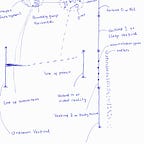Mind-Body Philosophy | Memory | Neurotechnology
Every internal and— accessible — external experience becomes a — graded — memory input. That is, an equivalent representation of that experience goes to its store.
A memory store has the least possible unique information. Everything else a store shares with others is grouped. Memory operations is dominated by stores transport across groups.
There is a default group for every store, which could be by use recurrence, recency or repercuss. A chair could be known as a sitting tool {recurrence}, standing tool to fix something {recency}, and rescue object from a problem {repercuss}. The first thing to think about that chair or what it means or represents is its default group — different for everyone.
Memory stores and groups work similarly for every internal and external sense — cells, nerves, organs, sights, words, smells, tastes and so on.
However, in what uniformity are memory stored? How does the memory get input?
In the brain, there is sensory integration to a uniform unit, relayed to be known and felt.
It is proposed to be thought or its form. It is in this form that the memory stores information. So while senses differ — across types and locations, they exist as thought or a form of thought in the memory.
Stores are capsules of thoughts and groups are clusters of stores.
After the memory, thoughts in stores are given to the destination of feelings and emotions — so that fear, happiness, anger and so on are felt, before a reaction — smile, scowl and so on.
Mind-Body Problem
It is store transport, speed, swell, and attached or rotating position in a group that is chiefly responsible for the mind-body problem.
Why?
All senses have stores {embassies or representatives} in the memory, from words to a particular odor to a certain touch to heart rate and so on.
If there is a word of something wrong, or sight of something falling, bodily processes spike because the store {of the word} hastily goes to a group of something wrong, a group that has accommodated other stores in the past.
The store swells, rotates the group and attaches recklessly, sending thoughts to the destination of fear, while a few other stores that had visited the group {or have an identifier} are attracted to that store, causing them to give off a mode, irregular with their operations.
Though store and group situation varies across conditions, it is how one store goes to a group that leads to mind-body affect.
Understanding the mind body problem from memory stores, adjusts understanding — including with active and passive thoughts {interchanges} overseeing automatic and controlled thoughts.
It also bears usefulness towards a new approach for the future of neurotech.
